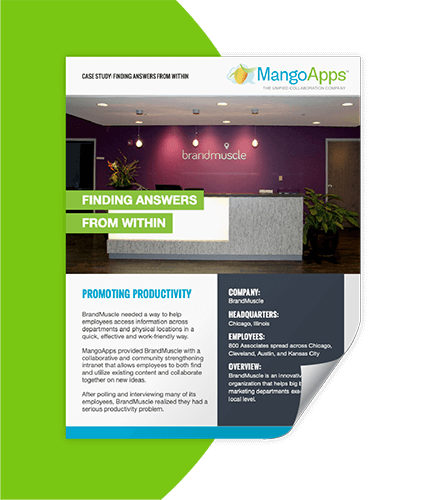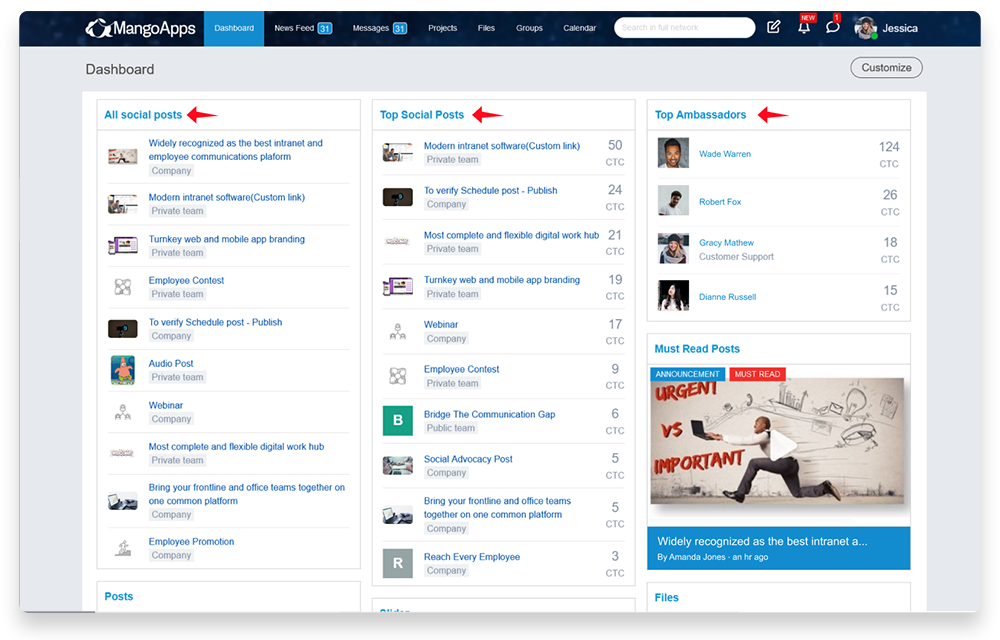Employee advocacy is a valuable tool. It increases employee engagement and helps your brand maintain a positive image. Rather than trusting celebrities or influencers to promote your company, why not trust your employees in that role? After all, they know and understand your organization better than anyone. And, more often than not, they want your company to succeed.
Plus, they’re already online – according to Backlinko, 50.64% of the world’s population uses social media – the majority being adults in the workforce. So, kill two birds with one stone by practicing employee advocacy on social media. Utilizing the people and resources already available, you can effortlessly execute an employee advocacy program via social media that benefits your employees and brand.
What is Employee Advocacy on Social Media?
Employee advocacy is the backing of a company by its personnel. This includes members of your workforce sharing company messages and promotions, communicating their positive work experiences, and recommending your company’s goods and services to friends and family.
While your employees can do all that in person, doing so on social media is highly effective and convenient. Rather than just reaching a handful of close friends and family, posts on social media have the ability to reach hundreds, if not thousands, of people. Because your employees are already participating in social media, it’s easy for them to share company content on their accounts once in a while.
Plus, chances are your employees already post original content about your company culture. Pictures from your Halloween costume contests, surprise catered lunches, and exciting product launches are just a few examples of employee advocacy posts your workforce is presumably sharing.

Encourage Content Creation & Collaboration
In this case study, learn how Brandmuscle used MangoApps to:
- Increase information sharing/accessibility
- Promote a culture of interdependence and collaboration
- Streamline their onboarding process
Why is Employee Advocacy on Social Media Important?
Employee advocacy on social media gives a personal touch to your company. It humanizes an otherwise faceless organization, improving the sense of trust between consumers and your company. Posts made by employee advocates give your company a sense of genuineness rather than perpetuating detached, biased producer/consumer exchanges.
Not to mention, employee advocacy on social media is incredibly beneficial across your entire organization. Both your company and employees gain from it. The impacts of social media employee advocacy include:
- Increased employee engagement, leading to a positive work environment
- The development of product/subject-matter experts
- Expanded networking
- Further reach of brand awareness

How Employees Benefit
- Networking opportunities: Social media in and of itself is non-stop interactions. When employees post brand-related content to their accounts, they naturally create networking opportunities. Gaining connections within their industry only helps their professional goals.
- Ready-to-use content: Creating engaging content takes time and effort. But if this content is provided, it’s an incentive for employees to post it on their own accounts. Whether they edit the copy to add their voice or post it verbatim, it’s a super easy task that takes almost no time to execute.
- Familiarization with social media: Statistically, many people use social media. But that doesn’t mean everyone uses it to the same extent. Some employees may not be super keen on social media but would still like to be an employee advocate for your company. Your readily available content will help them feel comfortable on social media platforms and convince them to post more.
- Builds thought leadership: Ready-to-go content and sharing industry-related articles allow your employees to gain knowledge. They will naturally become experts on your product and start to offer unique perspectives regarding your services.
How Your Brand Benefits
- Brand awareness and sales increase: According to Social Media Today, posts shared by employees rather than official brand accounts receive 800x more engagement. Findings show that 76% of people are more likely to trust content from an average person than a brand channel or its CEO. And, of that 76%, just over ¾ of them will make a purchase after receiving a recommendation from a friend or family member. In the end, consumers want to support their friends and family. Social advocacy on social media makes reaching friends, family, and beyond, extremely easy.
- Improves recruiting: When sharing positive workplace experiences and company culture insights on social media, others unwittingly consume this information. People become aware of your company just by scrolling through their friends’ feeds. So, when recruiters begin looking for new hires, they’ll come across people who are already interested in your company. Not to mention, your employees’ LinkedIn networks and social media followers are comprised of people they consider peers, and their peers are your ideal job candidates. As they post job openings on social media, your pool of potential hires will only contain fitting applicants.
What is an example of employee advocacy?
A classic example of employee advocacy is gifting company merch and swag to employees. Whether a branded water bottle or a graphic hoodie, when your employees use or wear these items in public, they inadvertently promote your brand. Plus, they get something new and practical for free! Be sure to be thoughtful in the design and execution of this merch, too. The more impressive the gift is, the more likely employees will post it on their socials.

Digital Hubs for the Modern Workplace
Outdated intranet solutions are simply not cutting it any more.
With employee experience at the top of the priority list, the demand for a modern platform that can house employee communications, work management, collaboration, and training is growing exponentially.
How do I encourage employee advocacy participation?
When implementing an employee advocacy program, you must accept that not everyone will want to participate. Employee advocacy should never be mandatory. It’s important to respect your employees’ work/life balance – maybe they prefer to keep the two separate, or perhaps they just aren’t fans of social platforms. That’s why it’s crucial to encourage employee advocacy rather than force it.
Here are some tips for enlisting members to your employee advocacy program:
- Furnish employee social media guidance: A major key of social media employee advocacy is personal expression and individualism. However, without any guidance whatsoever, employees could be hesitant to partake for fear of “doing something wrong.” Be sure to set policies regarding content and branding to steer everyone’s posts in the right direction. Include how often posts are published, the protocol for replying to comments, and what speaking style is used. By creating loose “to-do’s” and brand style guides, you can ensure your advocacy program is set up for maximum effectiveness while accurately portraying your company.
- Offer perks & incentives: While we covered how employees benefit from employee advocacy long-term, immediate accolades are often the most sought-after. Be sure to recognize and reward participating employees. Consider monetary incentives or employee recognition programs to encourage participation.
- Support employees’ personal brands: If you’re asking employees to post company content on their accounts, they must be able to let their personality shine while doing so. Encourage authenticity from their posts. Not only is it the respectful thing to do, but personalized posts that promote your brand will garner far more engagement.
- Equip employees with training tools: Some people just don’t use social media. If someone isn’t familiar with the app or platform, they might not be eager to participate in your social media advocacy program. To encourage participation, provide social media training. This will ensure everyone is comfortable, which will lead to higher engagement. Be sure to continue training depending on your program’s performance and platform updates.
- Set goals: If there isn’t a clear “why” in place, it’s likely that employees will dismiss the advocacy program altogether. It’s crucial to be transparent when asking for participation. Clearly state the goals of the program and how their contributions will help reach them. This doesn’t just ensure involvement in the advocacy program but also creates a sense of community and partnership within your organization. Your staff will feel appreciated and needed if they understand the outcomes of their efforts.

How does social media measure employee advocacy?
So, you’ve set up an employee advocacy program via social media, but how do you know if it’s working? Here are a few key points you can measure when establishing the success of your advocacy program:
- Organic reach: How many sets of eyes saw your company posts thanks to employee advocates? Organic reach refers to the number of people who saw your post without using ad money; keep track of this to determine the reach your advocates can achieve.
- Organic engagement: Like organic reach, organic engagement happens naturally on advocates’ posts at no cost to you. Measure the amount and types of discussions that occur on these posts. Also, take note of the kinds of content that garners engagement – are they behind-the-scenes photos, text-heavy achievement posts, quick videos showcasing new products, etc.? Use this data to drive the content of future posts, consistently increasing your organic engagement.
- Referrals: As mentioned above, employee advocacy posts help with recruiting. Be sure to set up a way of tracking leads that come to you through employees’ social media posts.
Employee Advocacy Platforms & Features
There’s a lot to consider when implementing an employee advocacy program. Which employees should be advocates, what content is appropriate for sharing, and whether your employee advocacy campaign is even working are just a few of the questions you’ll be asking yourself.
Luckily, MangoApps’ modern intranet platform comes equipped with in-depth employee social advocacy features to ensure your campaign is successful.
- Complete admin control: Domain administrators can determine whose and what type of content is available for social sharing, allowing full control over distributed company content.
- Public-facing posts: By enabling social advocacy on posts within your domain, public versions of these posts become viewable directly from LinkedIn & Twitter. Or, create a custom link that directs traffic to specific sites, like a company blog or job listing.
- Insights: Automatically track weekly click-through rates of social posts from your domain.
- Social advocacy widgets: Set up widgets within your domain that display: all social sharing-approved posts, the top-performing social posts, and your organization’s top advocates.

Boost your company’s employee advocacy efforts with MangoApps. Creating a successful employee advocacy program that increases brand awareness and employee engagement is easy with our all-in-one digital workspace platform. To learn more, visit mangoapps.com.







